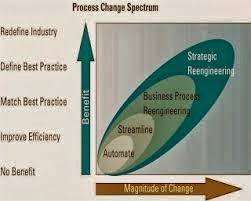STRATEGIC INITIATIVES
Organization can undertake high-profile strategic initiative including:-
Supply chain management (SCM)
- Involves the management of information flows between and among stages in a supply chain to maximize total supply chain effectiveness and profitability
Wal Mart And Procter & Gamble (P&G)

- Four basics component of supply chain management include:-
Customer relationship management (CRM)
-Involves managing all aspects pf a customer's relationship with an organization to increase customer loyalty and retention and an organization's profitability
-CRM is a strategy, process and business goal that an organization must embrace on an enterprisewide level
-CRM enable an organization to identify types of customers, design individual customer marketing campaign, treat each customer as an individual and understand customers buying behaviors

Business process re-engineering (BPR)
- Business Process is a standardized set of activities that accomplish a specific task.
- Business Process Reengineering (BPR) is the analysis and redesign of workflow within and between enterprises


.jpg)
Enterprise resource planning (ERP)
-ERP is an integrates all department and functions throughout an organization into a single IT system so that employees can make decision by viewing enterprise wide information on all business operation
-EPR system collect data from across an organization and correlates the data generating an enterprise wide view

Organization can undertake high-profile strategic initiative including:-
Supply chain management (SCM)
- Involves the management of information flows between and among stages in a supply chain to maximize total supply chain effectiveness and profitability
Wal Mart And Procter & Gamble (P&G)

- Four basics component of supply chain management include:-
- Supply chain strategy is the strategy for managing all the resources required to meet customer demand for all products and services.
- Supply chain partners are the partners chosen to deliver finished products, raw materials, and services including pricing, delivery, and payment processes along with partner relationship monitoring metrics.
- Supply chain operation is the schedule for production activities including testing, packaging, and preparation for delivery.
- Supply chain logistics is the product delivery processes and elements including orders, warehouses, carriers, defective product returns, and invoicing.
Effective and efficient SCM systems can enable an organization to;
o Decrease the power of its buyers
o Increase its own supplier power
o Increase switching costs to reduce the threat of substitute products or services
o Create entry barriers thereby reducing the threat of new entrants
o Increase efficiency while seeking a competitive advantages through cost leadership
Customer relationship management (CRM)
-Involves managing all aspects pf a customer's relationship with an organization to increase customer loyalty and retention and an organization's profitability
-CRM is a strategy, process and business goal that an organization must embrace on an enterprisewide level
-CRM enable an organization to identify types of customers, design individual customer marketing campaign, treat each customer as an individual and understand customers buying behaviors

Business process re-engineering (BPR)
- Business Process is a standardized set of activities that accomplish a specific task.
- Business Process Reengineering (BPR) is the analysis and redesign of workflow within and between enterprises
- An organization can improve the way it travels the road by moving from foot to horse and then horse to car. BPR looks at taking a different path such as an airplane which ignores the road completely.

- Progressive Insurance Mobile Claims Process

Types of change an organization can achieve along with the magnitudes of change and the potential business benefit:
.jpg)
Enterprise resource planning (ERP)
-ERP is an integrates all department and functions throughout an organization into a single IT system so that employees can make decision by viewing enterprise wide information on all business operation
-EPR system collect data from across an organization and correlates the data generating an enterprise wide view

No comments:
Post a Comment